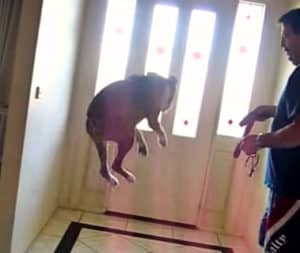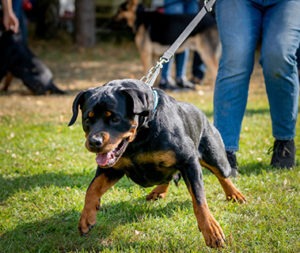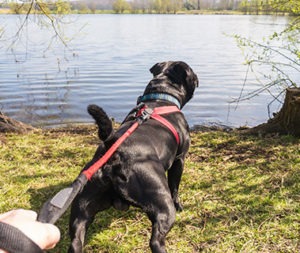
Why Is Walking My Dog Difficult?
The Top 5 Training Mistakes To Avoid When Training Your Dog To Walk.
Strolling the neighborhood with your buddy walking calmly by your side as you breeze through the neighborhood is a dog owner’s dream. But, if your dog walking experience looks more like playing tug-of-war out the door, getting pulled around on the leash, and apologizing to your neighbors, it can feel more like a nightmare.
Teaching your dog to walk nicely on the leash can be surprisingly simple but if you are making any of these top 5 training mistakes, it can get really complicated, really fast. Here are 5 of the top dog walking mistakes we see with tips on changes you can make to stop unwanted walking behavior and actually enjoy walking your dog.
The 5 Training Mistakes To Avoid On Walks
 MISTAKE #1: GETTING YOUR DOG TOO AMPED UP
MISTAKE #1: GETTING YOUR DOG TOO AMPED UP
Dogs LOVE going on walks, so when you pull out the leash and put on your walking shoes, it’s their signal to go bananas. They start panting, whining, running around, jumping on and off furniture and getting their pre-game on with all kinds of spastic energy. Most owners love seeing their dogs happy and want to join in on the celebration or even surprise their dogs by announcing “you wanna go on a WALK??”
It’s all in good spirits but, unfortunately, when it comes to walking – energy is everything. If your dog is overly excited and bouncing off the walls (literally), then they are in no state to be able to participate in a calm walking experience. That level of energy makes it hard for them to hear your voice and focus on what you want them to do. It can not only make for an annoying experience having to repeat yourself a dozen times, but can actually be dangerous if they are too amped up to hear your warnings.
A calm walk starts with a calm dog. If you want to set your dog up for success, resist the urge to get them all amped up, even if it is fun to watch them bounce around in joy. Keep things peaceful and make sure they are calm before you set out on your journey.
 MISTAKE #2: BOLTING OUT THE DOOR
MISTAKE #2: BOLTING OUT THE DOOR
We talked about the importance of a calm dog for having a calm walk. Once your dog has calmed down and has the right energy level for the walk, the next important step is paying attention to how you leave the house. One of our #1 rules when we train dogs is NO BOLTING. That means they are not allowed to dart over the threshold as soon as the door opens.
If your dog is pulling you out of the door or jutting out the gate, it can amp up their energy again and undo all the work you did to help them get calm. One thing we practice repeatedly before ever even leaving the doorway is just standing at the threshold with the door open and asking the dog to sit. We will even practice walking outside the door and going back in the house/training center several times to remove the excitement around leaving for a walk. We want them to be able to access a calm state-of-mind and not be triggered by the act of leaving.
 MISTAKE #3: ALLOWING PULLING, TUGGING, OR DARTING
MISTAKE #3: ALLOWING PULLING, TUGGING, OR DARTING
When dogs are left on their own to scavenge and sniff around, they naturally follow their nose…wherever it goes. Naturally, this looks like darting around, getting lost, and pulling and tugging toward whatever interesting smell, sight, or sound crosses their path..
When your dog is on a walk, it is a SHARED experience and it is not time for them to act independently and run wild. When you are training your dog to walk nicely on a leash, you are training them to travel with you in a structured walk. That means that you are in motion and moving together as a pack in a certain direction.
Teach your dog to stay focused by being structured and not allowing them to dart around, pulling, tugging and walking whichever direction their nose leads. Part of learning to walk is learning to stay in-tune with you and connected to your direction. If they get too focused on their own journey and what they are smelling, they will naturally start to pull and tug in the direction THEY want to go.
Correct them by keeping them at by your side and redirecting them when they dart across your path or pull/lunge towards objects of interest. When we train dogs to walk on a leash, we don’t allow frequent stopping and we especially don’t allow visits with strangers. A walk is for just that – walking.
 MISTAKE #4: BEING INCONSISTENT
MISTAKE #4: BEING INCONSISTENT
One of the most important aspects of training is consistency. When you are training your dog to walk nicely on a leash, it’s important to provide a consistent pattern to the way you structure your walk. This is everything from the way you leave the house (as we mentioned above) to the way you hold the leash, and the commands you use. If you sometimes allow your dog to dart around sniffing everything, or allow them to tug and pull around certain areas in the park but not others, it confuses them. They will have a much harder time understanding how to behave if it’s a moving target.
This is also true when it comes to your positioning during the walk. We recommend training your dog consistently with a heel at the same side every time. A “heel” command means that your dog is sitting or standing next to you at your side. You can use the heel command when you are stopped to have your dog sit calmly next to you or to stay at your side while you walk. Either way, teaching them a consistent position at your side gives them sort of a “home base” that helps them refocus and stay sensitive to your voice, gestures, or touches.
 MISTAKE #5: USING THE WRONG TOOLS
MISTAKE #5: USING THE WRONG TOOLS
We talk all the time with folks about the walking tools they choose for their dogs. One of the most common problems we see are people using tools that are not just ineffective but can actually work against your training efforts. For example, harnesses and especially harnesses with a clip in the middle of the back are actually similar to harnesses designed to HELP animals pull things like carts, wagons, sleds, etc. So using them while also trying to train your dog NOT to pull can pose a real problem as it gives them the urge to pull. Harnesses also provide significant leverage making it easier for your dog to pull you around the neighborhood.
There are a variety of different tools we recommend for on-leash walking. The top two are prong collars and e-collars. The reason we recommend these over all other walking tools, including flat collars is because they are the best way to be able to communicate with your dog quickly and in a way that they are more sensitive to. When used with proper safety and training these tools are actually more humane and require a lot less repetition and force. Please learn more about those tools here.
Another mistake is using a retractable leash. Many people like the function of retractable leashes but aren’t aware of their risks and drawbacks. Retractable leashes not only delay the time your dog can feel your tug and respond but can also malfunction and make it difficult for you to gain control when necessary.
Can you TEACH MY DOG TO WALK ON A LEASH?
We hope this guide has been helpful in diagnosing what might be getting in the way of you, your dog, and a peaceful walk. If you feel overwhelmed by this list and just aren’t sure where to start, we recommend looking into our training programs. We can help you sort out the issues and train your dog in the key skills it takes to perform a calm, structured walk you can both enjoy.
BONUS – Watch lead trainer, Malaika Heinbaugh share and demonstrate her top dog walking tips in this free dog training video.
